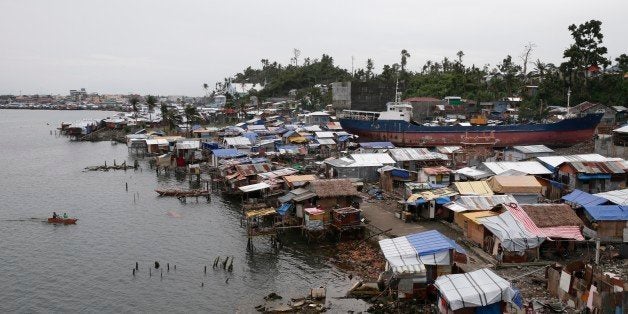
A year ago today, the most devastating Pacific Ocean storm ever hit the Philippines. It clocked top speeds of up to 195 miles per hour when it made landfall; leaving 6,300 people dead and up to 16 million people overall impacted. Known as "Yolanda" locally, the storm left an estimated 5.9 million working people without a source of income.
In their fourth and final report just out Sunday, a United Nations panel of scientific experts issued their starkest warning yet that climate change is causing "severe, pervasive, and in some cases irreversible detrimental impacts." In their previous reports, they stated with more certainty than ever before that climate change disproportionately impacts the poorest and most vulnerable among us.
As the people of the Philippines struggled to rebuild their lives in the immediate wake of Haiyan's destruction, world leaders met to decipher a proposed global agreement on how to address climate change and its impacts. Philippine negotiator Yeb Sano -- who went on a two-week hunger strike in solidarity with people in his country -- implored those crafting the U.N. Framework on Climate Change to match the extreme impacts of climate change with extreme will and solutions:
" ... I speak for the countless people who will no longer be able to speak for themselves after perishing from the storm. I also speak for those who have been orphaned by this tragedy. I also speak for the people now racing against time to save survivors and alleviate the suffering of the people affected by the disaster. We can take drastic action now to ensure that we prevent a future where supertyphoons are a way of life."
Like farmers and fishermen in the Philippines, hardworking people the world over don't need peer-reviewed reports to know their livelihoods are fraught by worsening rains, floods, droughts and famine.
Many of these same hardworking people, including labor union members, joined in global efforts to help put life back together again in the Philippines. Union nurses got emergency supplies to the Philippines, and also helped locate missing relatives. SEIU local unions in the United States and in Canada immediately gave financial support. A year later, new schools, cabs, boats and large-scale fish nets are nearly complete.
Working people are not only playing an integral role in providing emergency relief but also evoking long-term solutions. At the U.N. General Assembly meeting in New York City two months ago, working people were a sizable part of the record 100,000-plus marchers calling for real action to avert the injustice, economic inequality and missed economic opportunities that will come from inaction on climate change
As one commentator put it after Haiyan's devastation, greedy corporations left to their own devices would extract, export and exploit everything from gold to coconuts. World leaders must stand up with both robust preparedness and preventive solutions, protecting clean air, clean water, and the health and economic vibrancy of our communities.
World leaders must also acknowledge the concrete solutions self-interested entities call "extreme" are the same ones working people around the globe need to deal with the increasingly common and extreme impacts of climate change.
President Obama took an important first step earlier this year in moving to restrict coal-fired power plant emissions, the biggest source of pollution worldwide. The economically diverse nations of the European Union recently committed to reduce emissions by 40 percent over the next 15 years. China has reduced coal emissions. Although these are hopeful indicators, much more needs to be done.
In December, the world's attention will turn to climate change as world leaders meet in Peru for further work on that potentially pivotal framework agreement addressing climate change -- set to be finalized in Paris next year. It is time for world leaders to do what is best for all of us -- not just for wealthy corporations -- by making a rapid transition to a clean energy economy that creates and sustains good jobs.
Let there be no more devastation like Haiyan. Let us be the generation to leave the children we love a safer world and a more vibrant economy. Everyone's future depends on it.
